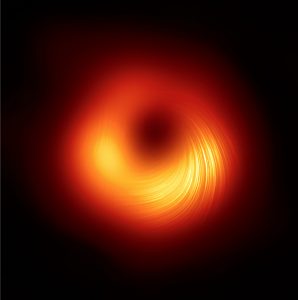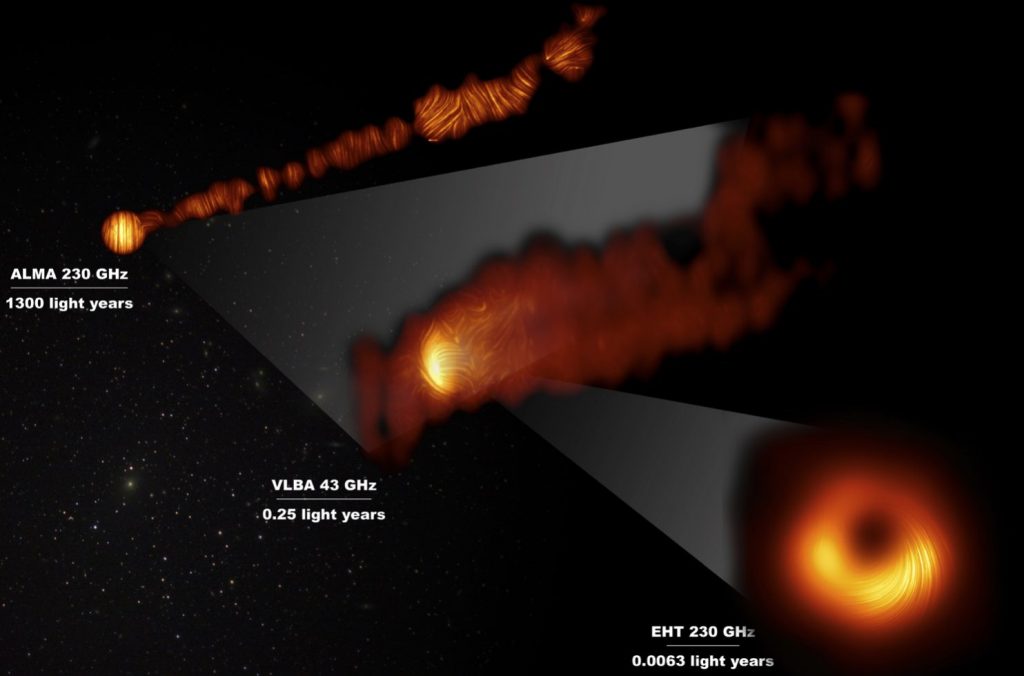Two Hawai`i-based telescopes, the James Clerk Maxwell Telescope (JCMT), operated by the East Asian Observatory, and the Submillimeter Array (SMA), operated by the Smithsonian Astrophysical Observatory and the Academia Sinica Institute for Astronomy and Astrophysics, have once again combined efforts with the global network of telescopes known as the Event Horizon Telescope. Today the image of Pōwehi, the Black Hole at the Centre of M87, has been shown in new light – specifically polarized light. The polarized light has enabled astronomers for the first time in history to measure polarization, a signature of magnetic fields, this close to the edge of a black hole. The observations are key to explaining how the M87 galaxy, located 55 million light-years away, is able to launch energetic jets from its core.
“We are now seeing the next crucial piece of evidence to understand how magnetic fields behave around black holes, and how activity in this very compact region of space can drive powerful jets that extend far beyond the galaxy,” says Monika Mościbrodzka, Coordinator of the EHT Polarimetry Working Group and Assistant Professor at Radboud University in the Netherlands.
On 10 April 2019, scientists released the first ever image of a black hole, Pōwehi, revealing a bright ring-like structure with a dark central region — the black hole’s shadow. Since then, the EHT collaboration has delved deeper into the data on the supermassive object at the heart of the M87 galaxy collected in 2017. They have discovered that a significant fraction of the light around the M87 black hole is polarized.

A view of the M87 supermassive black hole in polarized light. The Event Horizon Telescope (EHT) collaboration, who produced the first ever image of a black hole released in 2019, has today a new view of the massive object Pōwehi at the centre of the Messier 87 (M87) galaxy: how it looks in polarized light. This is the first time astronomers have been able to measure polarization, a signature of magnetic fields, this close to the edge of a black hole.This image shows the polarized view of the black hole in M87. The lines mark the orientation of polarization, which is related to the magnetic field around the shadow of the black hole. Credit: EHT
Light becomes polarized when it goes through certain filters. As an example many of us here in Hawai`i have polarized sunglasses, in space light can become polarized when it is emitted in hot regions of space that are magnetized. In the same way polarized sunglasses help us see better by reducing reflections and glare from bright surfaces, astronomers can sharpen their vision of the region around the black hole by looking at how the light originating from there is polarized. Specifically, polarization allows astronomers to map the magnetic field lines present at the inner edge of the black hole.
The bright jets of energy and matter that emerge from M87’s core and extend at least 5000 light-years from its centre are one of the galaxy’s most mysterious and energetic features. Most matter lying close to the edge of a black hole falls in. However, some of the surrounding particles escape moments before capture and are blown far out into space in the form of jets.
Hilo astronomer Geoff Bower who is the EHT Project Scientist said “These beautiful images tell an amazing story of how powerful magnetic fields control the black hole’s appetite and funnel part of its lunch out at nearly the speed of light. Producing these images was an incredible technical achievement from observations around the world to sophisticated image analysis.”
Astronomers have relied on different models of how matter behaves near the black hole to better understand this process. But they still don’t know exactly how jets larger than the galaxy are launched from its central region, which is as small in size as the Solar System, nor how exactly matter falls into the black hole. With the new EHT image of the black hole and its shadow in polarized light, astronomers managed for the first time to look into the region just outside the black hole where this interplay between matter flowing in and being ejected out is happening.

This composite image shows three views of the central region of the Messier 87 (M87) galaxy in polarised light. The galaxy has a supermassive black hole at its centre and is famous for its jets, that extend far beyond the galaxy. One of the polarised-light images, obtained with the Chile-based Atacama Large Millimeter/submillimeter Array (ALMA), shows part of the jet in polarised light, with a size of 6000 light years from the centre of the galaxy. The other polarised light images zoom in closer to the supermassive black hole: the middle view covers a region about one light year in size and was obtained with the National Radio Astronomy Observatory’s Very Long Baseline Array (VLBA) in the US. The most zoomed-in view was obtained by linking eight telescopes around the world to create a virtual Earth-sized telescope, the Event Horizon Telescope or EHT. This allows astronomers to see very close to the supermassive black hole, into the region where the jets are launched. The lines mark the orientation of polarisation, which is related to the magnetic field in the regions imaged.The ALMA data provides a description of the magnetic field structure along the jet. Therefore the combined information from the EHT and ALMA allows astronomers to investigate the role of magnetic fields from the vicinity of the event horizon (as probed with the EHT on light-day scales) to far beyond the M87 galaxy along its powerful jets (as probed with ALMA on scales of thousand of light-years). The values in GHz refer to the frequencies of light at which the different observations were made. The horizontal lines show the scale (in light years) of each of the individual images. Credit: © EHT Collaboration; ALMA (ESO/NAOJ/NRAO), Goddi et al.; VLBA (NRAO), Kravchenko et al.; J. C. Algaba, I. Martí-Vidal
The team found that only 0.1% of the theoretical models can explain what the astronomers are seeing at the event horizon. The new observations also revealed information about the structure and strength of the magnetic field just outside the black hole that astronomers didn’t have before.
“Our first glimpse of Pōwehi – a snapshot of the total light intensity – was like seeing the movie poster. Now, with our polarized glasses on, we have front row seats as the film begins. The polarized images show us how black holes do what they do and why we see what we see,” JCMT Deputy Director, Dr Jessica Dempsey states. “Our worldwide and home team pushed every technical, theoretical and observational boundary to achieve this. And we are still in the first minutes of the story. We have so much more to see. Pass the popcorn.”
To observe the heart of the M87 galaxy, the collaboration linked eight telescopes around the world, including the JCMT and SMA located on Maunakea, to create a virtual Earth-sized telescope, the EHT. The impressive resolution obtained with the EHT is equivalent to that needed to measure the length of a credit card on the surface of the Moon.
This allowed the team to directly observe the black hole shadow and the ring of light around it, with the new polarized-light image clearly showing that the ring is magnetized.
“The EHT is a one-of-a-kind facility to test the laws of physics in a region of extreme gravity. It gives us a unique chance to look at phenomena we have never studied before,” says EHT collaboration member Jongho Park, an East Asian Core Observatories Association Fellow at the Academia Sinica, Institute of Astronomy and Astrophysics in Taiwan.
Future EHT observations will reveal even more information about the mysterious region of space near the event horizons of supermassive black holes.The results are published today in two separate papers in The Astrophysical Journal Letters by the EHT collaboration. The research, which was coordinated by Mościbrodzka, involved over 300 researchers from multiple organisations and universities worldwide. Simon Radford, Director of Hawaii Operations, Submillimeter Array said “This research showcases the close cooperation between observatories in Hawai’i and elsewhere. The SMA and the JCMT have participated in the EHT for more than a decade. They will continue to play a major role in future EHT observations because of their location, their technology, and the dedication of their talented staff.”
Supplemental information
This research was presented in two papers published today in The Astrophysical Journal.
- Observational publication: First M87 Event Horizon Telescope Results. VII. Polarization of the Ring, ApJL March 24,2021
- Theory publication: First M87 Event Horizon Telescope Results. VIII. Magnetic Field Structure near The Event Horizon, ApJL March 24, 2021
- Related publication: Polarimetric properties of Event Horizon Telescope targets from ALMA, Goddi, Martí-Vidal, Messias, and the EHT Collaboration, ApJL March 24, 2021
The Event Horizon Telescope
The EHT collaboration involves more than 300 researchers from Africa, Asia, Europe, North and South America. The international collaboration is working to capture the most detailed black hole images ever obtained by creating a virtual Earth-sized telescope. Supported by considerable international investment, the EHT links existing telescopes using novel systems — creating a fundamentally new instrument with the highest angular resolving power that has yet been achieved.
The individual telescopes involved are: ALMA, APEX, the IRAM 30-meter Telescope, the IRAM NOEMA Observatory, the James Clerk Maxwell Telescope (JCMT), the Large Millimeter Telescope (LMT), the Submillimeter Array (SMA), the Submillimeter Telescope (SMT), the South Pole Telescope (SPT), the Kitt Peak Telescope, and the Greenland Telescope (GLT).
The EHT consortium consists of 13 stakeholder institutes: the Academia Sinica Institute of Astronomy and Astrophysics, the University of Arizona, the University of Chicago, the East Asian Observatory, Goethe-Universitaet Frankfurt, Institut de Radioastronomie Millimétrique, Large Millimeter Telescope, Max Planck Institute for Radio Astronomy, MIT Haystack Observatory, National Astronomical Observatory of Japan, Perimeter Institute for Theoretical Physics, Radboud University and the Smithsonian Astrophysical Observatory.
Pōwehi
Astronomers collaborated with renowned Hawaiian language and cultural practitioner Dr. Larry Kimura for the Hawaiian naming of the supermassive black hole at the centre of the galaxy M87. Pōwehi, meaning embellished dark source of unending creation, is a name sourced from the Kumulipo, the primordial chant describing the creation of the Hawaiian universe. Pō, profound dark source of unending creation, is a concept emphasized and repeated in the Kumulipo, while wehi, or wehiwehi, honored with embellishments, is one of many descriptions of pō in the chant. Dr. Kimura is an associate professor at University of Hawai‘i at Hilo Ka Haka ‘Ula o Ke‘elikolani College of Hawaiian Language.
Media Contacts
Geoff Bower
Chief Scientist for Hawaii Operations, ASIAA
Project Scientist, Event Horizon Telescope
Affiliate Graduate Faculty, UH Manoa Physics and Astronomy
gbower@asiaa.sinica.edu.tw
Jessica Dempsey
Deputy Director of the East Asian Observatory (EAO) and JCMT
j.dempsey@eaobservatory.org
Local Media Coverage



